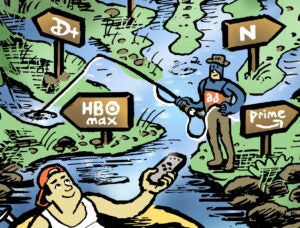“On TV & Video” is a column exploring opportunities and challenges in advanced TV and video.
Today’s column is by Sarah Lewis, global director for CTV at ShowHeroes Group.
Once upon a time, CTV was the new kid on the block. But it’s fast becoming an integral part of many advertisers’ video strategy.
Now, as the cookie phaseout throws a major curveball to players across the digital ecosystem, it’s important to understand the mechanics behind CTV and how users engage with it as a device.
At this critical time of evolving needs, connected TV is a rich, exciting opportunity. But the industry needs a unique blueprint to use it effectively. Advertisers and agencies that thrive will recognize the difference between CTV targeting and a legacy video strategy. Here are the key differences to consider as you shift gears.
A communal viewing experience
The use of first- and third-party data to facilitate granular audience targeting has been a core media strategy across desktop and mobile devices. However, CTV has a very different viewing experience than online video, particularly because of its more communal nature.
Research shows that audiences use CTV devices most heavily in the living room, where everyone can watch together. It’s therefore better to tackle connected TV as a shared platform and target contextually – based on the content consumers are viewing at a given time.
By the same token, advertisers shouldn’t target themselves into a corner by being overly specific. Only delivering, say, knitting content for an arts and crafts brand means you are unnecessarily narrowing your scope in this still-emerging sphere.
Different platform, different KPIs
Just as it’s important to understand how to effectively target on CTV, you’ll also need to adapt your campaign measurement. A rush to make your CTV advertising as measurable and interactive as possible fails to understand the fundamental nature of the platform.
When it comes to metrics, it’s not technically possible to measure CTV click-through rates. This is a good thing, since these are increasingly seen as a false economy metric.
Early on, advertisers technically couldn’t measure viewability on CTV either. Now, measurement solutions offer viewability pixels. But it’s still important to remember that, due to the nature of CTV, it is already inherently viewable.
Awareness-based metrics are therefore key, with View-through-rate (VTR) as the primary measure. There are also new solutions being launched, such as attribution using IP address matching and incremental reach measurement, which are far better ways to understand the effectiveness of your CTV campaign.
Too often, there is a check-the-box mentality that emphasizes the importance of metrics that aren’t actually relevant to a TV screen. If you cling to it too tightly, you may cut yourself off from a valuable alternative to build your brand and reach audiences.
Collaboration in the space
The connected TV ecosystem taking shape right now needs standardization and consistency. The sector should work with industry bodies like the IAB to make CTV solutions, benchmarks and terms as viable and uniform as possible.
The onus is also on providers to understand the needs of advertisers and agencies, drive the right solutions forward and provide transparency around their offerings. There is still confusion around simple concepts, such as where ads actually appear. But resources and training tools from the supply side can solve this problem.
Ownership of inventory can also be confusing. In the CTV space, it’s not just the content provider or broadcaster that monetizes the inventory. Rather, multiple providers, such as the device manufacturer, content aggregator/app or even channel-scheduling platform, can have a share. It therefore becomes more important for all players to adhere to industry frameworks, such as app-ads.txt, to create an easier-to-navigate market – and help regulate it.
The power of cinematic impact
To succeed in CTV, you don’t have to reengineer your video strategy from scratch. But you do need to adapt your thinking and benchmarks for success.
At its heart, CTV is ultimately TV advertising with digital capabilities. The big screen truly lends itself to an immersive experience. Where previously advertisers had to consider how they could create video ads that had a high impact on smaller screens, now is the time to think big. Tell a story. Make the most of a screen that can really showcase your brand.
CTV is a lean back realm. In a world of shouty banners and YouTube hype, it’s a long-form breath of fresh air where consumers stop to consider what they want to watch. Advertisers have the opportunity to be part of this engaged, decision-making process. In doing so, they may uncover exactly the kind of immersive consumer attention that many brands crave.
Follow ShowHeroes Group (@ShowHeroesGroup) and AdExchanger (@adexchanger) on Twitter.














